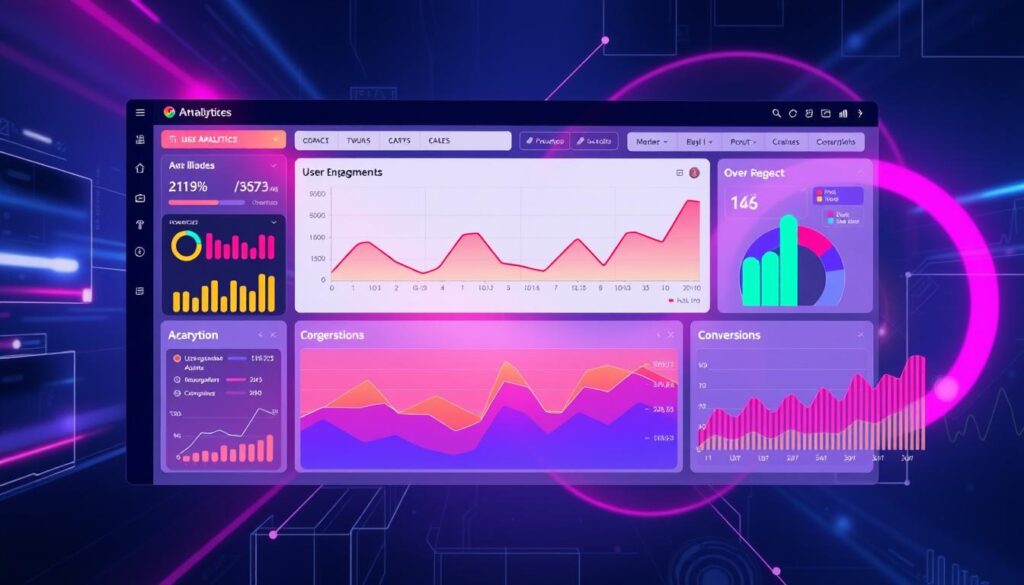In the digital world, user flow is key to a website or app’s success. It’s like a hidden map that guides visitors through your site, affecting how many convert. Understanding user flow is crucial for improving the customer journey and boosting conversions.
Good UX design makes the journey from landing to completing actions smooth. Clear navigation, logical layout, and strong calls-to-action guide users to conversion points.
A well-designed user flow also reduces mental effort, making it easier for visitors to reach their goals. By focusing on user flow, businesses can create experiences that please users and drive results.
Ready to dive deeper? Keep reading to explore actionable strategies for optimizing user flow and improving conversions.
Understanding User Flow and Its Importance
Funnel Analysis is important for improving user flow. It finds problems and areas for betterment in the user’s journey. For instance, user flow charts can check what’s working and what’s not. This helps designers make the user experience better, leading to more users and keeping them coming back.
There are different types of user flows for different needs. Task flows focus on certain actions, while wire flows mix wireframes with flowcharts for more context. These tools are essential in agile software development, helping shape feature functionality and ongoing support. User research, like interviews and surveys, helps make user flows effective, making sure they match user behavior and expectations. Good user flows do more than look nice. They help keep users interested and make the product successful. Making effective user flows for mobile apps means finding key features, mapping user paths, and testing them. This is vital for making the app better and keeping users happy, which boosts conversions and performance.
The Psychology Behind User Flow Design
User flow design explores the human mind deeply. It studies how we think and make choices. This helps create paths that are easy for users to follow. Behavior analytics is key here, showing us what users do and why.
Designers use psychology to make better experiences. They think about how much we can handle at once. They also consider what catches our attention. This makes interfaces feel natural to use.
Micro-interactions are small details that guide us. These small touches give feedback and encourage actions. For example, a button that changes color when clicked is a micro-interaction.
People prefer designs that look good. Beautiful interfaces are more popular. This ties into how we process information visually. Good design isn’t just about looks, though. It’s about making things easy to understand and use.
User flow design also thinks about habits. People like to do things the same way over and over. Smart designs use this to their advantage. They create flows that feel familiar and comfortable. This can lead to more people staying on a site or using an app.

User Flow Impact on Customer Decision-Making
User flow is key in shaping what customers decide. A good flow helps users move from awareness to making a purchase. It’s important to give the right info at each step, answering any questions they might have.
Customer Journey Mapping shows how users interact with products. For example, in online shopping, it starts at the homepage. Users then refine their search, check product details, add items to their cart, and finish the checkout.
Usability Testing gives us insights into how users behave. For instance, a coffee house app makes ordering fast and uses colors for actions. This makes the app better for users. Food delivery apps focus on easy menu browsing and cart management to keep users from leaving.
Looking at user flows can really help increase sales. It helps find and fix problems in the process. Common mistakes in user flow design can cause users to leave. By tracking flows like onboarding and payments, businesses can make the decision-making process smoother.
Mapping and Analyzing Current User Flows
Knowing how users move through your website is key to better User Experience Design. It’s about seeing the paths users take. This helps find where they start, what they do, and where they leave.
Tools like flowcharts and wireflows make these paths clear. They help show how users move through your site.
Behavior Analytics is essential for studying user paths. It tracks how users behave, showing common paths and where they get stuck. Heatmap tools give visual clues on where users click and scroll.
User testing also gives valuable feedback. It shows what’s working and what’s not. Combining this with data from analytics tools helps improve your site.
Good analysis looks at how engaged users are, how long they stay, and which pages they visit. By using analytics, you can make your site better. This leads to a better experience for everyone.
Common User Flow Bottlenecks and How To Address Them
User flow bottlenecks can really hurt your conversion rates. They include things like hard-to-use navigation, long forms, and slow websites. A study showed that fast websites can be 5 times better at converting than slow ones.
To fix these problems, make your site easier to navigate and forms shorter. Usability testing can show where users struggle. For instance, 71% of people want websites to know them personally, according to McKinsey.
Keep watching how users act to find new problems. Try out different fixes with A/B testing to see what works best. By always working on making your site better and testing it, you can make your users happier.
Leveraging Data Analytics for User Flow Optimization
Data analytics is key to improving user flows. Tools like Google Analytics offer insights into user behavior. This includes where users start, what paths they take, and where they leave.
Funnel Analysis shows where users drop off. This info is vital for better user experiences.
Behavior Analytics gives a deeper look at user interactions. Heatmaps and session recordings show how users interact. They highlight areas that cause confusion or frustration.
Designers can then make changes to improve user flows. This leads to better engagement and satisfaction.
Personalization through data analytics makes experiences more tailored. It boosts conversion rates by making user journeys smoother.
For data analytics to work in UI/UX design, teamwork is essential. Designers, data analysts, and strategists must collaborate. They need to balance creativity with data insights. This ensures designs are effective yet engaging.

A/B Testing Techniques for Refining User Flows
A/B testing is a key way to improve user flows and increase conversions. It compares two versions of a webpage or app to see which one works better. By looking at navigation, visuals, and calls to action, businesses can make their user experiences better.
Tools like Optimizely, VWO, and Google Optimize make A/B testing simple. They let designers test different parts of user flows, like how much info to show or what colors to use. For example, changing a CTA button from green to red led to a 21% increase in clicks.
For accurate results, it’s important to run A/B tests at the same time and focus on one thing at a time. This helps find out what really affects how users behave. By looking at things like how many people convert, how long they stay, and how often they leave, businesses can make smart choices to improve their user flows.
Keeping up with A/B testing is key for ongoing improvement. Companies that do this well can see big gains, like a 400% boost in conversion rates. By always making changes based on A/B test results, businesses can stay ahead and achieve better results.

Mobile-Specific Considerations in User Flow Design
Mobile user flow design faces unique challenges. With over 5 billion smartphone users worldwide, and 60% of website traffic from mobiles, creating smooth mobile experiences is key. Responsive design is crucial for adapting to different screen sizes and orientations.
Mobile app downloads have seen a 6.86% increase in 2020, reaching 218 billion. This shows the need for mobile-specific user flows. Designers must focus on touch-based interactions, simple navigation, and streamlined forms to improve the mobile experience. Fast load times are also vital for mobile users.
Tools like UXCam offer insights into mobile user behavior. These analytics help refine user flows and enhance app experiences. A/B testing different designs is vital to find the most engaging user flow. By using mobile-specific design patterns and progressive disclosure, designers can make mobile experiences more intuitive and user-friendly, leading to higher conversion rates.
Balancing Aesthetics and Functionality in User Flow
In User Experience Design, finding the perfect mix of looks and function is vital. Users make judgments about websites and apps in just a few seconds. This makes first impressions very important.
Visually appealing designs can make users feel connected. But, designs that work well meet user needs quickly and efficiently.
UI/UX Optimization is about combining good looks with practical features. First, figure out what users need and what might get in their way. This could be slow internet or disabilities.
Creating designs that everyone can use is key. Keep things simple and clear to make it easier for users to navigate.
The Aesthetic Usability Effect shows that people perceive pretty designs as more user-friendly. Use contrast and hierarchy to draw attention and keep users engaged. It’s important that looks and function go hand in hand, not fight each other.
Getting feedback and testing designs is crucial. It helps make designs better and improve the overall User Experience Design.
It’s all about finding a balance between beauty and usability. By focusing on both, you can make user flows that are stunning and effective. They meet user needs and help drive sales.
Maximize Conversions: The Impact of Optimized User Flows
User flow has a big impact on how many people convert. By improving user flow, businesses can see a big jump in their conversion rates. This also makes users happier.
Looking at task flow can really change things. It makes complex tasks easier and improves user experience a lot. By fixing problems, businesses can keep users coming back and make them happier. This smart design approach is essential for success.
Optimized user flows do more than just increase sales right away. They also make users more engaged, which helps build strong customer relationships and a better brand image. Using tools like surveys and analytics helps businesses understand what users want. Remember, making user flow better is an ongoing effort. It’s all about keeping up with user behavior and business goals to keep improving.
Creating an intuitive user flow isn’t just about numbers — it’s about understanding your audience and delivering an experience that truly resonates. If you’re ready to take your designs to the next level, explore more at Mood Joy for actionable insights and design tips.



